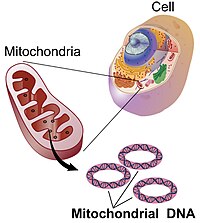
Photo from wikipedia
Heteroplasmy is the existence of more than one mitochondrial DNA (mtDNA) variant within a cell. The evolutionary mechanisms of heteroplasmy are not fully understood, despite being a very common phenomenon.… Click to show full abstract
Heteroplasmy is the existence of more than one mitochondrial DNA (mtDNA) variant within a cell. The evolutionary mechanisms of heteroplasmy are not fully understood, despite being a very common phenomenon. Here we combined heteroplasmy measurements using high throughput sequencing on green turtles ( Chelonia mydas ) with simulations to understand how heteroplasmy modulates population diversity across generations and under different demographic scenarios. We found heteroplasmy to be widespread in all individuals analysed, with consistent signal in individuals across time and tissue. Significant shifts in haplotype composition were found from mother to offspring, signalling the effect of the cellular bottleneck during oogenesis as included in the model. Our model of mtDNA inheritance indicated that heteroplasmy favoured the increase of population diversity through time and buffered against population bottlenecks, thus indicating the importance of this phenomenon in species with reduced population sizes and frequent population bottlenecks like marine turtles. Individuals with recent haplotypes showed higher levels of heteroplasmy than the individuals with ancient haplotypes, suggesting a potential advantage of maintaining established copies when new mutations arise. We recommend using heteroplasmy through high throughput sequencing in marine turtles, as well as other wildlife populations, for diversity assessment, population genetics, and mixed stock analysis.
Journal Title: Scientific Reports
Year Published: 2020
Link to full text (if available)
Share on Social Media: Sign Up to like & get
recommendations!